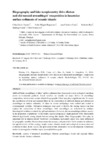Mostrar o rexistro simple do ítem
Biogeography and lake morphometry drive diatom and chironomid assemblages’ composition in lacustrine surface sediments of oceanic islands
| dc.contributor.author | Pereira, Cátia Lúcio | |
| dc.contributor.author | Raposeiro, Pedro | |
| dc.contributor.author | Costa, Ana Cristina | |
| dc.contributor.author | Bao, Roberto | |
| dc.contributor.author | Giralt, Santiago | |
| dc.contributor.author | Gonçalves, Vítor | |
| dc.date.accessioned | 2017-03-16T13:01:52Z | |
| dc.date.available | 2017-03-16T13:01:52Z | |
| dc.date.issued | 2014 | |
| dc.identifier.citation | Pereira, C.L., Raposeiro, P.M., Costa, A.C. et al. Hydrobiologia (2014) 730: 93. doi:s10750-014-1824-6 | es_ES |
| dc.identifier.issn | 1573-5117 | |
| dc.identifier.uri | http://hdl.handle.net/2183/18283 | |
| dc.description.abstract | [Abstract] Subfossil biotic assemblages in lakes’ surface sediments have been used to infer ecological conditions across environmental gradients. Local variables are usually the major drivers of assemblage composition, but in remote oceanic islands biogeographic filters may play a significant role. To assess the contribution of local and regional filters in the composition of subfossil diatom and chironomid assemblages in surface sediments, 41 lakes in Azores archipelago were studied and related to environmental variables. Ordination techniques were used to identify the forcing factors that best explain the composition of these assemblages. Both assemblages are influenced by multiple limnological variables (conductivity, pH and nutrients). However, diatom assemblages differed mainly in the proportion of planktonic versus benthic species along lakes’ depth gradient while chironomids differed significantly among islands but not among lake depths. Thus, biogeographic filters play an important role in shaping islands’ freshwater communities, particularly insect ones, more influenced by geographic variables. Results demonstrate the accuracy and potential of biotic remains in sediments for applied studies of lake ecology, trophic status, climatic trends and ecological reconstruction and evolution of lakes. In the Azores, the application of this information for the development of inference models is envisaged as a further step to accomplish these goals. | es_ES |
| dc.description.sponsorship | Part of this study was financed by the Fundo Regional da Ciência e Tecnologia (M3.1.7/F/009/2011) and the PaleoNAO project of the Spanish Ministry of Education (CGL2010-15767). We thank the Freshwater Ecology Group from the University of the Azores for all the help in field and laboratory work. The surveys performed comply with the current laws of Portugal | es_ES |
| dc.description.sponsorship | Azores. Fundo Regional da Ciência e Tecnologia; M3.1.7/F/009/2011 | es_ES |
| dc.language.iso | eng | es_ES |
| dc.publisher | Springer | es_ES |
| dc.relation | info:eu-repo/grantAgreement/MICINN/Plan Nacional de I+D+i 2008-2011/CGL2010-15767/ES/EVOLUCION DE LA NAO DURANTE LOS ULTIMOS 15000 AÑOS EN LA PENINSULA IBERICA Y EN AZORES A PARTIR DEL ESTUDIO DE REGISTROS LACUSTRES Y DATOS CLIMATICOS INSTRUMENTALES/ | |
| dc.relation.uri | https://doi.org/10.1007/s10750-014-1824-6 | es_ES |
| dc.rights | The final publication is available at Springer via https://doi.org/10.1007/s10750-014-1824-6 | es_ES |
| dc.subject | Azores | es_ES |
| dc.subject | Chironomid assemblages | es_ES |
| dc.subject | Diatom assemblages | es_ES |
| dc.subject | Local and regional filters | es_ES |
| dc.subject | Oceanic islands | es_ES |
| dc.subject | Surface sediments | es_ES |
| dc.title | Biogeography and lake morphometry drive diatom and chironomid assemblages’ composition in lacustrine surface sediments of oceanic islands | es_ES |
| dc.type | info:eu-repo/semantics/article | es_ES |
| dc.rights.access | info:eu-repo/semantics/openAccess | es_ES |
| UDC.journalTitle | Hydrobiologia | es_ES |
| UDC.volume | 730 | es_ES |
| UDC.issue | 1 | es_ES |
| UDC.startPage | 93 | es_ES |
| UDC.endPage | 112 | es_ES |
Ficheiros no ítem
Este ítem aparece na(s) seguinte(s) colección(s)
-
GI-GRICA - Artigos [49]






